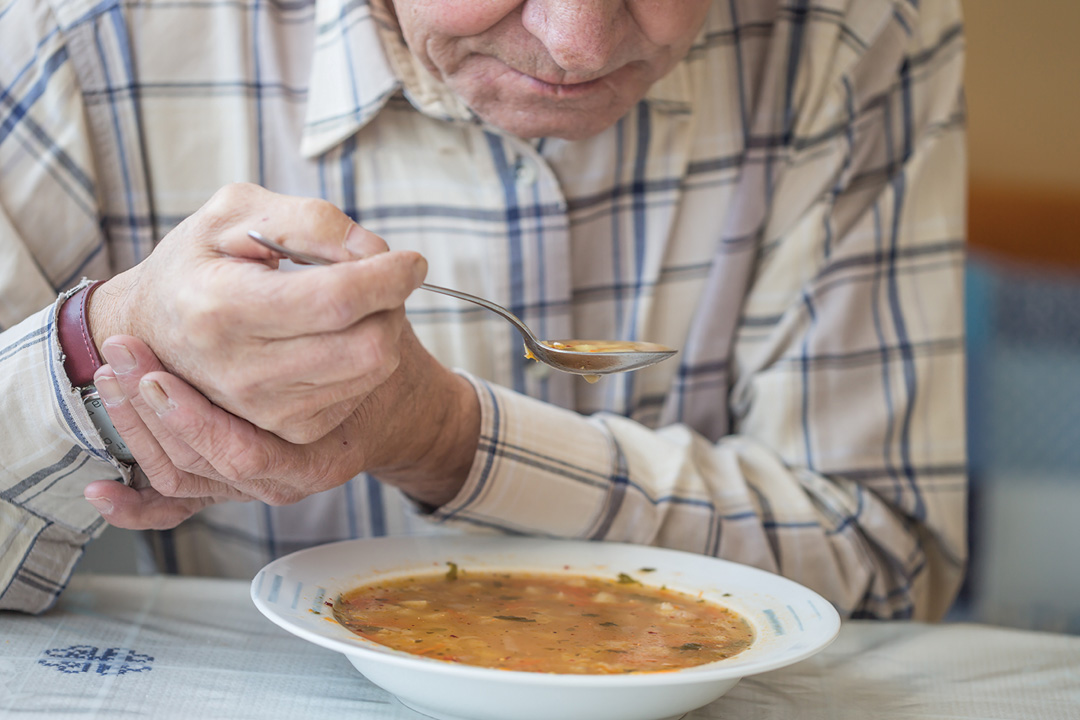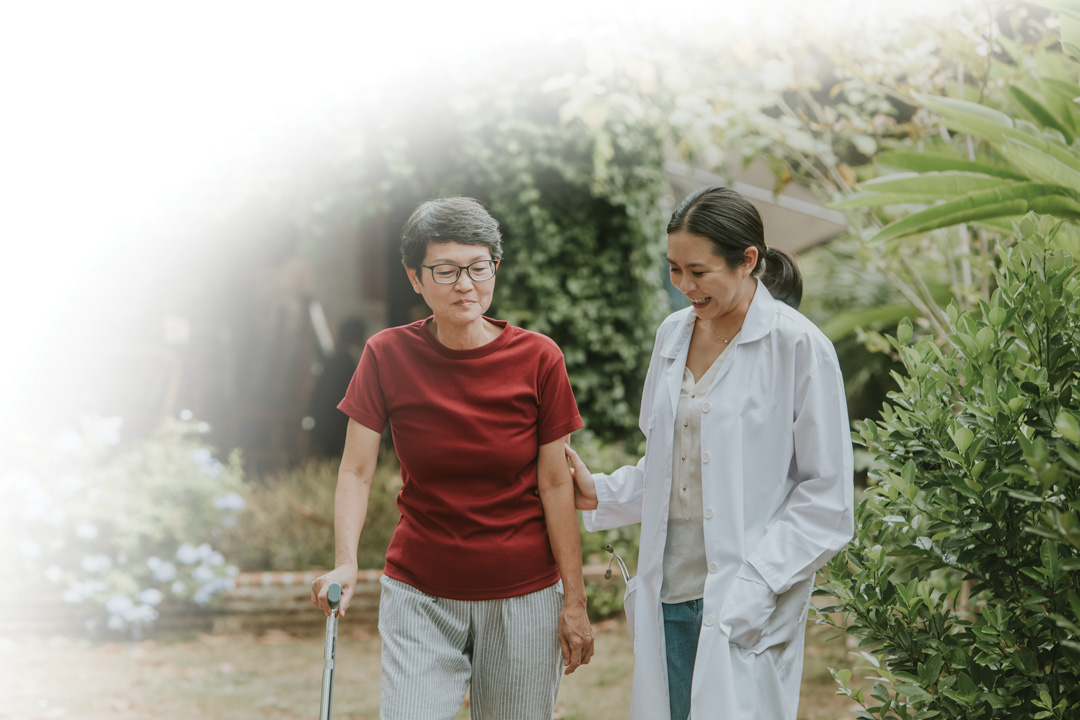
Ron Till, 69, was exhausted. Two years earlier he had lost the ability to have a good night’s sleep. He would go to bed early, only to be awoken by his body jerking violently. Experiencing a rest tremor like this is just one of his many symptoms of Parkinson’s disease.
But things changed for the better when he signed up for a novel clinical trial assessing the effectiveness of infrared light therapy for Parkinson’s.
“It improved my sleep so much,” said Till, who lives in Mannum, South Australia. Within weeks of commencing the trial, which involved applying infrared light therapy to his head and abdomen, three times a week, for 12 weeks, he stopped jerking awake. “I got back my two blocks of four-hour sleep, which is like gold to me.”
Till was so pleased with his improvement that once the study ended he purchased a light helmet device used in the trial and continues to use it for 20 minutes every second day. He credits his ongoing use of light therapy for preventing his Parkinson’s symptoms from getting worse—claiming the treatment has stopped any noticable disease progression. “Since I started the light treatment I’ve plateaued so nicely that my neurologist has reduced my three-monthly visits to yearly,” he said.
The results of the trial, which involved 19 participants in NSW and SA, showed that Till was not an isolated case, with most participants demonstrating improvements in Parkinson’s symptoms and signs including gait, balance, cognition and fine motor skills after receiving infrared light therapy. In addition, the trial examined for, and found, changes in the participants’ gut microbiome, which meant that this was the first known trial worldwide to demonstrate changes in the human gut microbiome following infrared light therapy.

Marianvejcik—Getty Images
The Australian study’s microbiome findings, which are being published in The Journal of Photochemistry & Photobiology B: Biology, offer a potential ray of hope for the approximately 80,000 Australians and 10 million people worldwide who are facing a long, slow decline from a progressive neurodegenerative disease with limited treatment options.
The number of cells in the gut microbiome, which is comprised of all the bacteria, protozoa and fungi that colonise the gastrointestinal tract (GIT), is estimated to be a hundred trillion, which is as many as the number of cells in the rest of our entire body. There has been increased interest in the gut microbiome over recent years, with dysbiosis (an unbalanced microbiome) being linked to a number of medical disorders, including neurodegenerative disease, cardiovascular disease, asthma, diabetes, irritable bowel syndrome (IBS), inflammatory bowel disease (IBD), colorectal cancer and obesity.
There has long been a postulated link between Parkinson’s disease, the gastrointestinal tract and the gut microbiome. The gut microbiome in Parkinson’s patients has been shown to be altered compared to those of the general population. Constipation affects 90 per cent of Parkinson’s sufferers, often preceding the initial diagnosis by many years. And there is an increased risk of Parkinson’s disease in those who already have IBS or IBD.
The reason for this link is undetermined, however the prime suspect is a protein known as alpha-synuclein. Abnormal accumulations of this protein in nerve cells form microscopically visible lesions known as Lewy bodies which are associated with a decreased ability to repair DNA damage and increased cell death. Lewy bodies have been detected in the GIT up to 20 years before the diagnosis of Parkinson’s disease. They are also present in high numbers in the brain of Parkinson’s patients, especially in the basal ganglia.
It is hypothesised that inflammation leads to increased alpha synuclein accumulation in the GIT, with some of this excess being transported to the brain via the vagus nerve. This hypothesis is supported by the fact that those who have undergone a surgical transection of the vagus nerve are less likely to develop Parkinson’s disease.
Improvements in the gut microbiome may reduce GIT inflammation and permeability, thereby reducing alpha-synuclein transportation to the brain, as well as increasing beneficial microbial metabolic byproducts such as serotonin, GABA and dopamine, thereby reducing the risk of Parkinson’s disease and improving symptoms in those who already have the disease.
Australasian Research Institute’s Dr Ann Liebert and her colleagues had already found, through earlier research, that the gut microbiome of mice could be altered through administration of infrared light therapy. They wished to see if this finding could be replicated in humans. Nineteen volunteers were recruited, all aged between 60 and 80 and with mild to moderate symptoms and signs of Parkinson’s.
The participants gave a faecal sample to researchers before the trial began, and were asked not to alter their dietary habits or day-to-day activities during the duration of the study. The participants were then given infrared light therapy via laser devices to their abdomen and to their head and/or their neck, three times a week for 12 weeks. Then a further faecal sample was collected from each participant, and the microbiome from each of these faecal samples was subsequently analysed via DNA extraction and testing.
“It was incredibly exciting to see changes in the microbiome and improvements in symptoms happening at the same time,” Liebert said. “Even more excited when we saw the same kind of changes in the Sydney trial where we treated the abdomen only.”
The majority of participants showed a significant increase in 10 different genera of microorganisms including Bacteroides, Alistipes and Prevotella and a significant decrease in 17 different genera including Bifidobacterium, Streptococcus and various Clostridium and Enterococcaceae genera.
Interestingly two of the bacterium that showed an increase—Bacteroides and Prevotella—have been shown in multiple studies to be reduced in the gut microbiome of Parkinson’s sufferers. In fact low levels of Prevotella is so strongly associated with a more rapid progression and greater severity of Parkinson’s that it has been proposed as a biomarker for the disease. And Bacteroides is considered beneficial to the microbiome through its anti-inflammatory properties and production of healthy short chain fatty acids.

Erdark—Getty Images
Five of the bacteria that showed a decrease post-light therapy—Bifidobacterium, Streptococcus, Lactobacillus, Christensenella and Enterococcacea— have been shown in multiple studies to be increased in the microbiome of Parkinson’s sufferers.
“It is quite possible that laser will provide a synergistic effect to the currently available therapeutic manoeuvres [to the gut microbiome],” Professor of Cardiology at Macquarie University, Hosen Kiat, said. “It is a no-brainer if it is useful because it is relatively cheap, it is non-invasive and it has zero side effects.”
Not all the microbiome findings, however, were as expected. Both Lactobacillus and Bifidobacterium are considered to be beneficial to the microbiome, yet both bacteria showed a significant decrease in the majority of participants following light therapy.
“We know that very few diseases have a magic bullet treatment,” Kiat said. “But if I were a Parkinson’s patient I would seek out the laser and I would use the same protocol as we described.”
It is impossible at this stage to know whether the improvements in the trial participants’ Parkinson’s symptoms were due to the effect of infrared light therapy to the brain, or due to changes in the gut microbiome, or partially due to a placebo effect, or, most likely, a combination of the above. What is unquestioned however is that exposure to light therapy did alter the gut microbiome, seemingly for the better, and that further research in this area is urgently needed.
What is also apparent is the gratitude of the trial participants for being introduced to light therapy. With his Parkinson’s symptoms in check, Till plans to do more travelling. “I have family up on the Gold Coast. And I think to myself, Can I drive that far? Before it was impossible but now I think, Perhaps I can.”
Suvi Mahonen is a freelance journalist specialising in reporting on medical research. She lives in the Gold Coast, Queensland.









